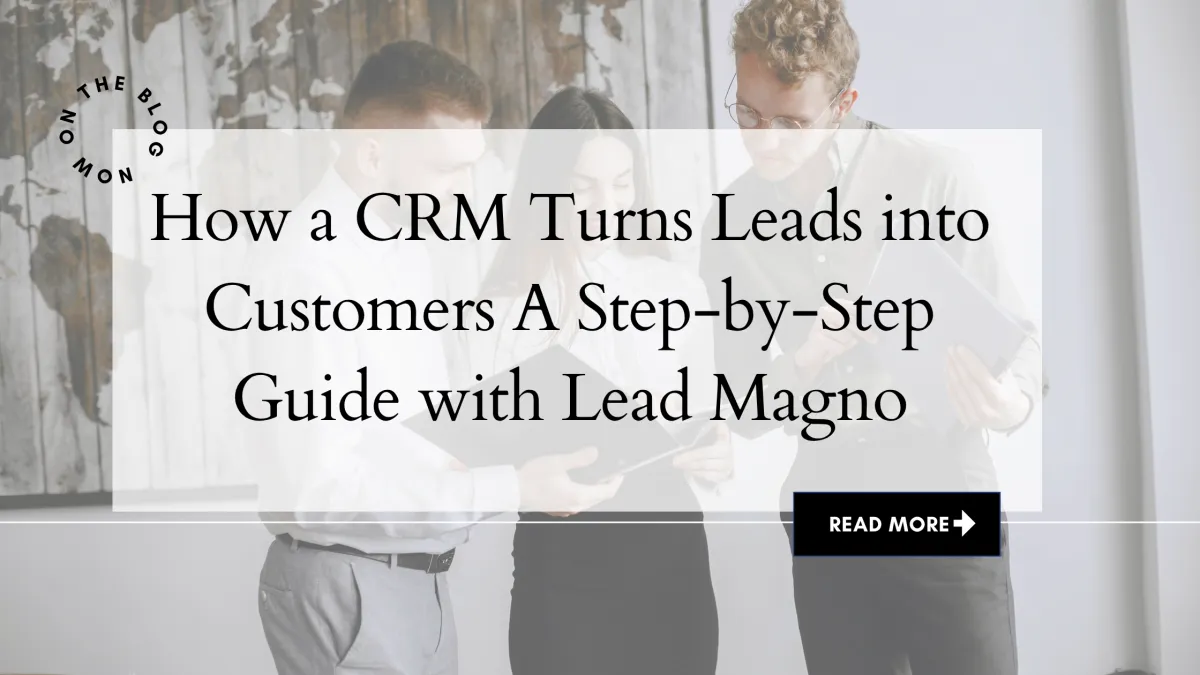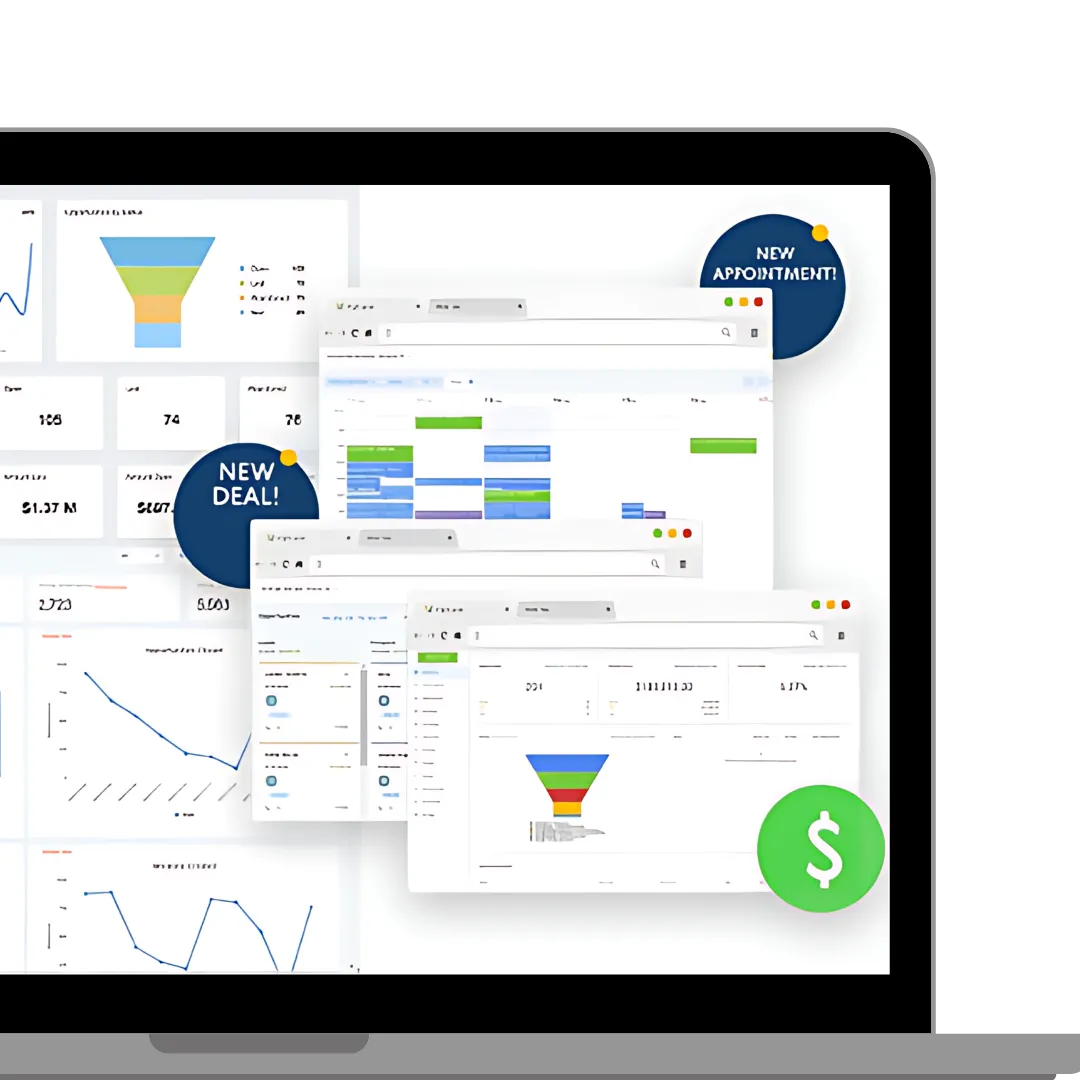
How a CRM Turns Leads into customers
How Does a CRM Work? From Lead Capture to Pipeline to Automation:
Customer Relationship Management (CRM) software is the central hub that takes a raw inquiry (like a website form submission) and guides it through a structured journey to become a customer – all while tracking every step. In simple terms, a good CRM collects leads from various sources, organizes them into a sales pipeline, automates follow-ups, and measures the resultsbizople.commonday.com. This end-to-end process ensures no prospect falls through the cracks and helps businesses turn initial interest into loyal customers. In this blog, we’ll walk through the CRM flow step-by-step – lead capture, pipeline management, automation workflows, and reporting – explaining how each piece works. We’ll start with the basics for beginners (what happens right after someone fills out your form) and then dive into more advanced features. Along the way, we’ll highlight how modern all-in-one platforms like Lead Magno (powered by GoHighLevel) and other popular CRMs handle these steps, and what makes solutions like Lead Magno/GHL stand out.
Lead Capture: Turning Visitors into Leads
Every CRM journey begins with capturing information about a potential customer – the lead. Most often, this happens through an online form. In fact, almost everyone has filled out a lead capture form at some point – for example, when signing up for an email newsletter, downloading an ebook, or registering for a webinarmonday.com. That simple act of entering your name, email, or phone number is gold for businesses. The CRM’s job is to collect and centralize that data immediately so you can act on it.
Lead capture forms can live on your website, landing pages, or social media ads. Some CRMs provide built-in form and landing page tools (Lead Magno offers native form builders and funnel pages in its platform, similar to GoHighLevel’s approach), while others integrate with third-party form providers. Either way, when a visitor submits a form, the CRM automatically creates a lead record with those details. Modern CRMs can pull in leads from multiple channels – not just website forms. For example, a CRM might also ingest leads from email inquiries, live chat conversations, social media campaigns, or even offline eventsbizople.com. No matter the source, all leads funnel into one database where your team can start working on them.
Importantly, the CRM doesn’t just store the contact info – it can also tag the lead’s source (e.g. “Website Contact Form” or “Facebook Ad”) and any other context you’ve asked for (like product interest or company size). This aggregation of lead data is powerful: you can later analyze it, route it to the right salesperson, or trigger tailored follow-upsmonday.com. For beginners, think of it this way: instead of sticky notes or spreadsheet entries, you have a living system where every new inquiry instantly shows up, ready for you to engage. And if you’re using an all-in-one platform like Lead Magno, the capture is seamless – a form submission on your Lead Magno site immediately becomes a lead in your CRM without any manual import.
Pipeline: Organizing and Tracking Your Opportunities
Once leads are captured, what happens next? This is where the CRM pipeline comes in. A pipeline is essentially a visual tracker of your sales process, broken into stages. Each stage represents a step toward becoming a customer – for example: New Lead, Contacted, Demo Scheduled, Proposal Sent, and Closed (Won/Lost). The CRM automatically places new leads into the first stage of the pipeline (often called something like “New” or even a dedicated “Lead Capture” stage)help.gohighlevel.com, and from there, you and your team move them along as the relationship progresses.
An example of a CRM pipeline view with stages as columns (New Lead, Contacting, etc.). Each card represents a lead or deal, which can be dragged from left to right as it advances. CRMs like Lead Magno provide an Opportunities Pipeline interface that gives a clear visual of where every prospect is in the sales journey.
In a pipeline view (sometimes called a Kanban board style), each lead or opportunity is shown as a card under its current stage column. This makes it easy to see your overall sales at a glance: how many leads are in the “New” stage vs. how many are nearing “Closing,” for instancebizople.com. Salespeople can click into a card to see all the details (contact info, notes, past interactions) and update progress. Most CRMs let you drag-and-drop cards between stages to update status – e.g. when a lead books a meeting, you drag them from “New” to “Appointment Scheduled.” In Lead Magno’s pipeline (leveraging GoHighLevel’s system), moving a card can even trigger certain automations (more on that shortly). The pipeline isn’t just for show; it’s a working tool that enforces consistency and organization. Every stage has a clear meaning, so your whole team knows what’s going on with each lead.
The pipeline view also helps prioritize actions. For example, if you see a big stack of leads stuck in “Contacted – No Response,” you might decide to send a special follow-up or assign those to a specific rep. A well-defined pipeline standardizes your process so no lead is forgotten. As HighLevel’s own documentation notes, pipelines provide visibility into where every deal stands, ensure consistency in how leads are handled, and even enable automation of routine tasks like reminders when something sits too longhelp.gohighlevel.com. In short, the CRM pipeline is your control center for lead management. Whether you use HubSpot, Salesforce, or Lead Magno, this concept is similar – though the terminology might differ (some call each opportunity a “deal” or “ticket”). The key is that you have a structured “assembly line” for your customer journeyhelp.gohighlevel.com, from initial interest to final outcome.
Pro Tip: Define your pipeline stages to match your business’s process and keep it simple. For instance, Lead Magno recommends using clear stage names aligned with your sales strategy, such as New Lead → Booked Appointment → Showed Up → Closed/Won, etc., so it’s immediately obvious where a lead standstech.leadmagno.com. The simpler and more action-oriented your stages, the easier it is to manage. And because Lead Magno’s pipeline is fully integrated, leads from your forms flow straight into the first stage without any manual work – a huge time-saver compared to juggling spreadsheets or separate systems.
Automation & Workflows: Nurturing Leads on Autopilot
Capturing leads and moving them through a pipeline is great – but doing all the follow-up manually can be a huge task. This is where CRM automation (often through “workflows” or “campaigns”) makes a game-changing difference. Automation in a CRM means the software can take predefined actions for you based on triggers or rules. The goal is to keep leads engaged and things moving forward 24/7, without relying on a human to remember every task. As one CRM provider puts it, automation can “capture potential customers, segment them, and guide them toward the sale, all in real time, 24 hours a day, without human intervention.”kommo.com In other words, your CRM becomes an always-on assistant that nurtures your prospects.
So what kinds of things can workflows automate? A common example is sending an immediate follow-up email or text as soon as a lead fills out your form. Rather than someone on your team manually writing a “Thanks for contacting us, here’s next steps” email, the CRM’s workflow sends it instantly. This quick touch makes the lead feel acknowledged right away. Another typical automation is scheduling tasks or reminders. For instance, if a new lead comes in, the CRM might automatically create a task for a sales rep to call them within 1 day. If the lead replies to your email or books an appointment via a calendar link, the system can move them to the next pipeline stage and perhaps assign them a new owner (maybe an account executive instead of a qualifier).
A conceptual “digital pipeline” illustrating how automated actions can be added at each stage of the sales process. For example, upon Lead Capture, the CRM might send a welcome email or SMS; during the Nurture stages, it could assign follow-up tasks or launch an email drip campaign; and as you Close deals, it might send invoice links or post-sale surveys. Workflows in platforms like Lead Magno (GoHighLevel) let you visually build these if-then sequences, ensuring every lead is touched with the right message at the right time.
Modern CRMs offer quite sophisticated workflow builders. Lead Magno, for instance, provides a visual automation builder (from its GHL backbone) where you can drag and connect triggers and actions – no coding needed. Triggers could be things like “Form Submitted,” “Pipeline Stage Changed,” or “Appointment No-Show,” and actions can range from “Send Email/Text,” “Add a Tag,” “Wait 3 days,” “Update Pipeline Stage,” to more advanced steps like “If Lead has not responded, then …” logic. By stringing these together, you create an automated lead nurturing sequence. For example, you might design a workflow: When a new web form lead comes in, immediately email a welcome message, then wait 1 day and notify a sales rep to call, and if no reply in 3 days, send a reminder email. All of that happens in the background once you set it up.
The benefit of automating these processes is huge for efficiency. It frees your team from repetitive admin busywork, so they can focus on actual conversations and closing dealsmonday.com. According to a Monday CRM article, automating lead capture and follow-up not only saves time but also helps you respond faster, which means you’re more likely to turn that lead into a customermonday.com. For instance, your CRM can trigger an instant notification to your team when a lead engages – say, opens an email or clicks a link – prompting them to follow up at just the right momentmonday.com. Workflows can also ensure leads get routed correctly: many systems will auto-assign leads to specific sales reps or teams based on criteria (like territory or product interest) as soon as they qualifymonday.com. This kind of intelligent routing is baked into Lead Magno’s automation, leveraging tags, pipelines, and triggers to make sure the right person handles each lead.
Beyond responding and routing, automation can improve lead quality over time. How? By tracking lead behavior and applying lead scoring or segmentation rules automatically. For example, as mentioned earlier, some CRMs (including Lead Magno/GHL via custom values and triggers) allow you to increment a lead’s score when they take certain actions (opened email, visited pricing page, etc.). This helps identify hot prospects without manual reviewmonday.com. Automated data enrichment is another advanced feature – integrating tools that add publicly available info to a lead’s profile, or verifying their email and phone automatically, saving your team research time.
It’s worth noting that not all CRMs have the same level of automation built-in. Traditional sales CRMs might require add-on marketing automation software to do what an all-in-one platform does natively. For example, Salesforce often needs a separate product like Pardot/Marketing Cloud for complex email workflows, whereas Lead Magno (via GoHighLevel) has workflows, SMS/email marketing, and even voicemail drops all under one roof. Even HubSpot, which has both CRM and marketing capabilities, gates many automation features in higher-tier plans. This is where Lead Magno shines for growing businesses – you get robust automation capabilities without needing multiple tools or enterprise budgets. The consistency of automated follow-ups ensures every lead is nurtured systematically. As one source put it, automation offers consistency and time savings, handling tasks like follow-up emails or reminders so teams can focus on high-priority interactionsbizople.com. Your CRM essentially becomes an extra team member that never sleeps.
Reporting & Analytics: Learning from the Data
A major advantage of managing your lead-to-customer flow in a CRM is the wealth of data it generates – and modern CRMs come with dashboards and reports to turn that data into insight. Reporting and analytics tell you how well your process is working and where you can improve. Once you have leads flowing in, moving through pipeline stages, and being worked via automated and manual touchpoints, the CRM is tracking each step. Good CRM reporting will show you metrics like: how many leads were captured this week, where those leads came from, conversion rates from one stage to the next, how long leads stay in each stage on average, and ultimately how many convert into customers (and at what value).
A sample CRM analytics dashboard showing key sales pipeline metrics. Comprehensive reporting (as provided in platforms like Lead Magno’s Insights Dashboard) can include visualizations of conversion rates per stage, total deals in each stage, revenue forecasting, campaign performance, and team activity. Having all your lead and pipeline data in one system enables real-time tracking of your marketing and sales effectiveness.lead magno
For beginners, the most important thing reports show is your conversion funnel: out of 100 leads captured, how many became opportunities, how many got to proposal, and how many closed? If you see a big drop-off at a certain stage, that’s a flag that needs attention (maybe lots of leads book calls but then don’t show up – indicating a need for better reminders or qualification). CRMs like Lead Magno include “All Reporting” in their package (available from the Pro plan and up)leadmagno.com, meaning you can generate detailed reports on everything from ad campaign ROI to pipeline velocity. According to an Odoo CRM overview, robust reporting lets you analyze sales performance, lead conversion rates, and customer behaviors, which empowers you to refine your strategies and make better decisionsbizople.com. In other words, you’re not guessing what’s working – the CRM data tells you.
Some key CRM reports and analytics include:
Lead Source Analytics: See which sources are bringing in the most leads and the highest-converting leads (e.g., perhaps 50% of your leads come from Facebook Ads, but the ones from organic search close twice as often – valuable insight!).
Pipeline Stage Metrics: Track how many leads are in each stage, the conversion percentage from stage to stage, and the win rate overall. A HighLevel knowledge base article notes that you should use reporting to answer questions like “Where do leads drop off most often? Which stage takes the longest? What’s the win rate at each stage?”help.gohighlevel.com. Having this data shows you where the bottlenecks are in your funnel.
Sales Cycle Length: Measure the average time it takes for a lead to go from first contact to closed deal. This can help forecast sales and identify if certain stages are causing delays.
Campaign or Workflow Performance: If you’re running multiple marketing campaigns or automated sequences, CRM reports can compare their results (e.g., leads from Campaign A converted at 10% versus Campaign B at 5%).
Individual Performance: For teams, you can often see metrics per sales rep or per marketing channel, which helps in coaching and allocating resources effectively.
Revenue and Forecasting: By inputting deal values, a CRM can project expected revenue by month or quarter based on pipeline and conversion rates, and then show actual vs. predicted outcomes as deals close.
Lead Magno’s integrated reporting means you can slice and dice this information easily because all the data lives in one platform – your forms, pipeline, emails, etc., are not scattered across different tools. This comprehensive view is a big plus of all-in-one CRMs. Even if you are a small business just starting with a CRM, paying attention to a few basic reports (like leads per week and conversion rates) can inform your tactics. And as you get more advanced, you can leverage things like custom dashboards or export data for deeper analysis. The bottom line is, a CRM not only streamlines the work, it also measures the work, providing actionable insights. As the saying goes, “You can’t improve what you don’t measure.” With CRM analytics, you can measure, then tweak your process to get better results over timebizople.com.
Traditional vs. All-In-One CRMs: Why Integration Matters
We’ve described the CRM process in a general way – capture leads, manage a pipeline, automate follow-ups, and analyze results. Most modern CRMs, from well-known names like HubSpot and Salesforce to niche players, follow this same framework. However, not all CRMs are equal in how they handle each step. Some systems focus mainly on one part of the process and require integrations or add-ons for the rest. For example, a sales-focused CRM might give you great pipeline tools but no email marketing module (meaning you’d have to connect it to MailChimp or another system for nurturing). On the other hand, all-in-one platforms like Lead Magno (built on GoHighLevel) or HubSpot aim to provide end-to-end coverage so that forms, pipeline, automation, and analytics all live in one ecosystem.
HubSpot has long been known for its robust CRM with marketing, sales, and service tools, but its full power often comes at a premium cost as you layer on features. GoHighLevel, which powers Lead Magno, takes a different approach by bundling a wide array of features geared towards marketing agencies and businesses into one package. As HighLevel’s own site describes, it “presents an all-in-one CRM solution that integrates marketing, automation, and agency-focused tools into one platform.”blog.gohighlevel.com This means in Lead Magno, you don’t just get a contact database – you also get a form builder, funnel/page builder, email and SMS blaster, appointment scheduler, two-way texting, pipeline management, workflow automation, invoicing, reputation management – the list goes on (truly covering the entire customer lifecycle). Many traditional CRMs would require 3-5 different software tools connected together to match what a single all-in-one offers. By having everything under one roof, an integrated CRM ensures data flows seamlessly from one step to the next. For example, the lead’s activity timeline (a feature in most CRMs) will automatically include their form submission, every email or text sent via automation, every pipeline move, etc., since it’s all the same system. In a fragmented setup, you might miss pieces of that story or have to manually stitch it together.
From a neutrality standpoint, it’s worth noting that each approach has its fans. Some businesses prefer a dedicated CRM and separate specialized tools for marketing, giving them flexibility to mix-and-match “best of breed” solutions. However, the trend (especially for small businesses and agencies) is strongly toward all-in-one for simplicity and cost efficiency. HighLevel (and thus Lead Magno) is popular among marketing agencies because it’s not only comprehensive but also highly cost-effective for the feature setblog.gohighlevel.comblog.gohighlevel.com. HubSpot, by comparison, can become quite expensive as you upgrade for automation and reporting features beyond the free tierblog.gohighlevel.comblog.gohighlevel.com.
Example: A small business using HubSpot’s free CRM might still need to pay for an email automation tool if they want drip campaigns, whereas with Lead Magno, that capability is included out-of-the-box. Similarly, scheduling software (Calendly, etc.) might be an extra tool for some CRM users, but Lead Magno has calendars built-in (as GoHighLevel offers integrated appointment schedulingblog.gohighlevel.com). The advantage of platforms like Lead Magno and GHL is having everything work together natively – your web forms feed directly to pipeline, your pipeline stages can trigger your workflows, your workflows log activities that feed your reports, and so on, without a tangle of third-party integrations.
Of course, other top CRMs are also expanding into all-in-one territory. HubSpot itself offers both CRM and Marketing Hub in one platform; Salesforce has an ecosystem of clouds (Sales Cloud, Marketing Cloud). There are also CRM suites like Zoho that combine multiple apps. The difference often comes down to ease-of-use and target audience. Lead Magno, following GoHighLevel’s philosophy, is designed with agencies and small businesses in mind – it even allows white-labeling the platform for agencies, a feature not found in most mainstream CRMsblog.gohighlevel.com. What this means for a user is that the interface is geared toward quickly launching campaigns, pipelines, and automations without needing a ton of technical admin work.
In practical terms, whether you use an all-in-one CRM or a combination of tools, the workflow we outlined in this post remains valid. If you’re using separate systems, you just have to ensure they talk to each other (for instance, use Zapier or native integrations to send form fills into your CRM, and to trigger emails from your marketing tool when pipeline stages change). It’s doable, but requires setup and can be fragile. With an integrated CRM like Lead Magno or GoHighLevel, those hand-offs are built internally – it’s your form builder, your pipeline, your automation in one login – making the whole lead management process smoother and more foolproof.
Conclusion
A CRM is more than just an address book for your contacts – it’s the engine that drives your customer acquisition and retention process. By capturing leads, organizing them in a pipeline, automating key touches, and tracking the outcomes, a CRM allows businesses to scale up their sales and marketing efforts with consistency and insight. We started from the moment a prospect raises their hand (by filling a form or contacting you), and followed the journey through nurturing and ultimately conversion, with the CRM guiding the way. If you’re a beginner, focus on getting those first two pieces right: use your CRM to centralize all leads and define a clear pipeline with stages. Then add automation step by step – even a simple autoresponder and task reminder can dramatically improve follow-up rates. Finally, keep an eye on your CRM’s reports to learn what’s working. For more advanced users, take advantage of features like workflow branching, lead scoring, and campaign attribution to refine your process further.
Whether you’re using a big name like HubSpot or a specialized platform like Lead Magno, the core principles don’t change – but having an all-in-one solution can certainly make life easier by unifying the lead capture-to-close loop. Lead Magno (powered by GoHighLevel) exemplifies this by providing forms, pipeline, automation, and analytics in one package, along with unique extras (SMS marketing, social media integration, etc.) that enhance the CRM workflow. By contrast, many traditional CRMs might handle the pipeline well but rely on plugins for the rest. As you evaluate CRM options, consider how each step of your lead flow will be handled. The best CRM for you is one that fits your business size and needs, and one that you will actually use consistently.
In summary, a CRM works by capturing leads, turning them into structured opportunities, automating the follow-up process, and continuously learning from the results. Mastering this flow means you can respond faster to inquiries, manage your sales efforts more efficiently, and ultimately win more business – all while maintaining a great experience for your leads and customers. With the right CRM practices in place, you’ll ensure that when someone fills out your form or calls your business, they won’t slip through the cracks. Instead, they’ll be guided thoughtfully from that first touch to a successful relationship, supported every step of the way by your CRM system’s capabilities.
Ready to turn every lead into a loyal customer?
Discover how Lead Magno’s all-in-one CRM automates your sales, follow-ups, and reporting — so nothing slips through the cracks.
👉 Book a quick demo with Lead Magno
Let’s walk you through how our CRM can simplify your lead flow from capture to close.









Facebook
Instagram
X
LinkedIn
Youtube
TikTok